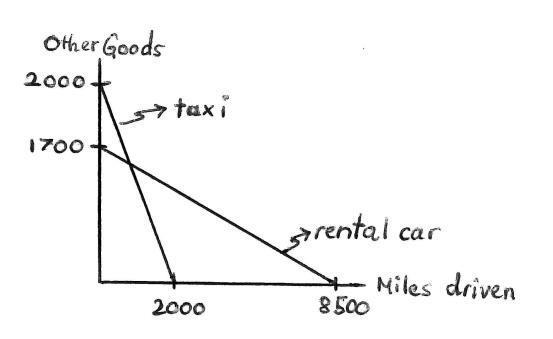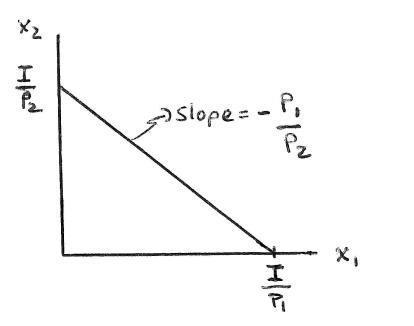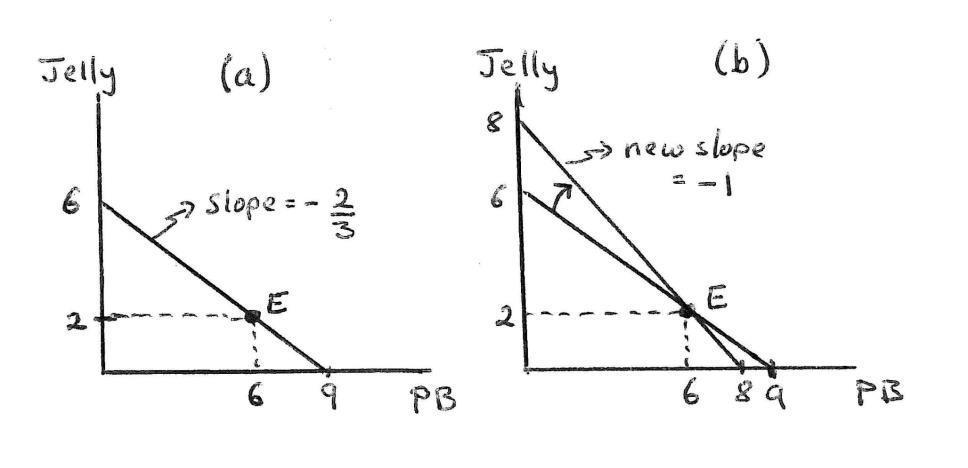
10 minute read
Choice Sets and Budget Constraints Choice Sets and Budget Constraints
from Solution manual for microeconomics an intuitive approach with calculus 2nd edition thomas nechyba 13
B:Derive the mathematical equations for my budget constraint and my brother’s budget constraint, and relate elements of these equations to your graphs in part A Use x1 to denote miles driven and x2 to denote other consumption
Answer: My budget constraint, once I pay the rental fee, is 0 2x1 + x2 = 1700 while my brother’s budget constraint is x1 + x2 = 2000 These can be rewritten with x2 on the left hand side as
Advertisement
The intercept terms (1700 for me and 2000 for my brother) as well as the slopes ( 0 2 for me and 1 for my brother) are as in Exercise Graph 2 6
(a) Where in your budget equation for me can you locate the opportunity cost of a mile driven?
Answer: My opportunity cost of miles driven is simply the slope term in my budget equation i e 0 2 I give up $0 20 in other consumption for every mile driven.
(b) Where in your budget equation for my brother can you locate the opportu-nity cost of a mile driven?
Answer: My brother’s opportunity cost of miles driven is the slope term in his budget equation i.e. 1; hegives up $1 in other consumption for every miledriven.
Everyday Application: Dieting and Nutrition: On a recent doctor’s visit, you have been told that you must watch your calorie intake and must make sure you get enough vitamin E in your diet
A: You have decided that, to make life simple, you will from now on eat only steak and carrots. A nice steak has 250 calories and 10 units of vitamins, and a serving of carrots has 100 calories and 30 units of vitamins Your doctor’s instruc-tions are that you must eat no more than 2000 calories and consume at least 150 units of vitamins per day
(a) In a graph with “servings of carrots” on the horizontal and steak on the vertical axis, illustrate all combinations of carrots and steaks that make up a 2000 calorie a day diet.
Answer: This is illustrated as the “calorie constraint” in panel (a) of Ex-ercise Graph 2 7 You can get 2000 calories only from steak if you eat 8 steaks and only fromcarrots if you eat 20 servingsof carrots. These formthe intercepts of the calorie constraint
Exercise Graph 2.7 : (a) Calories and Vitamins;
(b)
Budget Constraint
(b) On the same graph, illustrate all the combinations of carrots and steaks that provide exactly 150 units of vitamins.
Answer: This is also illustrated in panel (a) of Exercise Graph 2 7 You can get 150 units of vitamins from steak if you eat 15 steaks only or if you eat 5 servings of carrots only. This results in the intercepts for the “vitamin constraint”.
(c) On this graph, shade in the bundles of carrots and steaks that satisfy both of your doctor’s requirements.
Answer: Your doctor wants you to eat no more than 2000 calories which means you need to stay underneath the calorie constraint Your doctor also wants you to get at least 150 units of vitamin E which means you must choose a bundle above the vitamin constraint. This leaves you with the shaded area to choose from if you are going to satisfy both require-ments.
(d) Now suppose you can buy a serving of carrots for $2 and a steak for $6 You have $26 per day in your food budget. In your graph, illustrate your budget constraint If you love steak and don’t mind eating or not eating carrots, what bundle will you choose (assuming you take your doctor’s instructions seriously)?
Answer: With $26 you can buy 13/3 steaks if that is all you buy, or you can buy 13 servings of carrots if that is all you buy This forms the two inter-cepts on your budget constraint which has a slope of p1/p2 = 1/3 and is depicted in panel (b) of the graph If you really like steak and don’t mind eating carrots one way or another, you would want to get as much steak as possible given the constraints your doctor gave you and given your budget constraint. This leads you to consume the bundle at the intersection of the vitamin and the budget constraint in panel (b) indicated by (x1 , x2 ) in the graph. It seems from the two panels that this bundle also satisfies the calorie constraint and lies inside the shaded region
B:Continue with the scenario as described in part A
(a) Define the line you drew in A(a) mathematically
Answer: This is given by 100x1 + 250x2 = 2000 which can be written as
(b) Define the line you drew in A(b) mathematically
Answer: This is given by 30x1 + 10x2 = 150 which can be written as
(c) In formal set notation, write down the expression that is equivalent to the shaded area in A(c).
Answer:
2 ª (x1 , x2 )R + | 100x1 + 250x2 ≤ 2000 and 30x1 + 10x2 ≥ 150 (2 7.iii)
(d) Derive the exact bundle you indicated on your graph in A(d).
Answer: We would like to find the most amount of steak we can afford in the shaded region Our budget constraint is 2x1 +6x2 = 26 Our graph sug-gests that this budget constraint intersects the vitamin constraint (from equation (2 7 ii)) within the shaded region (in which case that intersec-tion gives us the most steak we can afford in the shaded region). To find this intersection, we can plug equation (2 7.ii) into the budget constraint 2x1 + 6x2 = 26 to get and then solve for x1 to get x1 = 4 Plugging this back into either the bud-get constraint or the vitamin constraint, we can get x2 = 3 We know this lies on the vitamin constraint as well as the budget constraint. To check to make sure it lies in the shaded region, we just have to make sure it also satisfies the doctor’s orders that you consume fewer than 2000 calories The bundle (x1 , x2 )=(4,3) results in calories of 4(100) + 3(250) = 1150, well within doctor’s orders.
Everyday Application: Setting up a College Trust Fund: Suppose that you, after studying economics in college, quickly became rich so rich that you have nothing better to do than worry about your 16-year old niece who can’t seem to focus on her future Your niece currently already has a trust fund that will pay her a nice yearly income of $50,000 starting when she is 18, and she has no other means of support.
A:You are concerned that your niece will not see the wisdom of spending a good portion of her trust fund on a college education, and you would therefore like to use $100,000 of your wealth to change her choice set in ways that will give her greater incentives to go to college.
(a) One option is for you to place $100,000 in a second trust fund but to restrict your niece to be able to draw on this trust fund only for college expenses of up to $25,000 per year for four years On a graph with “yearly dollars spent on college education” on the horizontal axis and “yearly dollars spent on other consumption” on the vertical, illustrate how this affects her choice set.
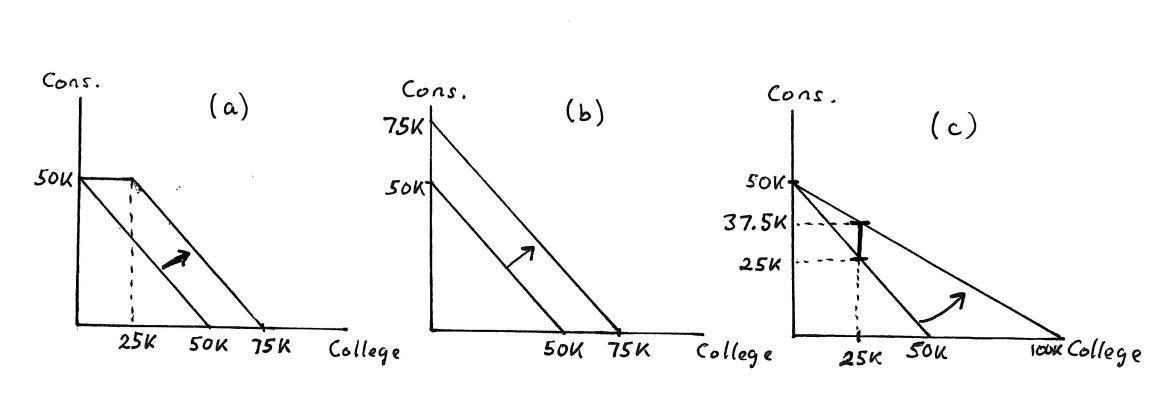
Answer: Panel (a) of Exercise Graph 2.8 illustrates the change in the bud-get constraint for this type of trust fund The original budget shifts out by $25,000 (denoted $25K), except that the first $25,000 can only be used for college Thus, the maximum amount of other consumption remains $50,000 because of the stipulation that she cannot use the trust fund for non-college expenses. Exercise
(b) A second option is for you to simply tell your niece that you will give her $25,000 per year for 4 years and you will trust her to “do what’s right”. How does this impact her choice set?
Answer: This is depicted in panel (b) of Exercise Graph 2 8 it is a pure income shift of $25,000 since there are no restrictions on how the money can be used
(c) Suppose you are wrong about your niece’s short-sightedness and she was planning on spending more than $25,000 per year from her other trust fund on college education Do you think she will care whether you do as described in part (a) or as described in part (b)?
Answer: If she was planning to spend more than $25K on college anyhow, then the additional bundles made possible by the trust fund in (b) are not valued by her. She would therefore not care whether you set up the trust fund as in (a) or (b)
(d) Suppose you were right about her she never was going to spend very much on college Will she care now?
Answer: Nowshe will care because she would actuallychoose one of the bundles made available in (b) that is not available in (a) and would therefore prefer (b) over (a).
(e) A friend of yours gives you some advice: be careful your niece will not value her education if she does not have to put up some of her own money for it Sobered by this advice, you decide to set up a different trust fund that will release 50 cents to your niece (to be spent on whatever she wants) for every dollar that she spends on college expenses. How will this affect her choice set?
Answer: Thisisdepictedin panel (c) ofExerciseGraph 2.8.If your niecenowspends $1 on education, she gets 50 cents for anything she would like to spend it on so, in effect, the opportunity cost of getting $1 of additional education is just 50 cents. This “matching” trust fund therefore reduces the opportunity cost of education whereas the previous ones did not.
(f ) If your niece spends $25,000 per year on college under the trust fund in part (e), can you identify a vertical distance that represents how much you paid to achieve this outcome?
Answer: If your niece spends $25,000 on her education under the “match-ing” trust fund, she will get half of that amount from your trust fund or $12,500. This can be seen as the vertical distance between the before and after budget constraints (in panel (c) of the graph) at $25,000 of education spending
B: How would you write the budget equation for each of the three alternatives discussed above?
Answer: The initial budget is x1 +x2 = 50, 000. The first trust fund in (a) expands this to a budget of x2 = 50, 000 for x1 ≤ 25, 000 and x1 + x2 = 75, 000 for x1 > 25, 000, (2 8) while the second trust fund in (b) expands it to x1 + x2 = 75, 000 Finally, the last “matching” trust fund in (e) (depicted in panel (c)) is 0 5x1 + x2 = 50, 000
Business Application: Pricing and Quantity Discounts: Businesses often give quantity discounts. Below, you will analyze how such discounts can impact choice sets.
A: I recently discovered that a local copy service charges our economics depart-ment $0.05 per page (or $5 per 100 pages) for the first 10,000 copies in any given month but then reduces the price per page to $0 035 for each additional page up to 100,000 copies and to $0 02 per each page beyond 100,000 Suppose our department has a monthly overall budget of $5,000
(a) Putting “ pages copied in units of 100” on the horizontal axis and “dol-lars spent on other goods” on the vertical, illustrate this budget constraint. Carefully label all intercepts and slopes.
Answer: Panel (a) of Exercise Graph 2 9 traces out this budget constraint and labels the relevant slopes and kink points.
(b) Suppose the copy service changes its pricing policy to $0 05 per page for monthly copying up to 20,000 and $0 025 per page for all pages if copying exceeds 20,000 per month (Hint: Your budget line will contain a jump.)
Answer: Panel (b) of Exercise Graph 2.9 depicts this budget. The first portion (beginning at the x2 intercept) is relatively straightforward The second part arises for the following reason: The problem says that, if you copy more than 2000 pages, all pages cost only $0.025 per page includ-ing the first 2000. Thus, when you copy20,000 pages per month, you total bill is $1,000. But when you copy 2001 pages, your total bill is $500 025
(c) What is the marginal (or “additional”) cost of the first page copied after 20,000 in part (b)? What is the marginal cost of the first page copied after 20,001 in part (b)?
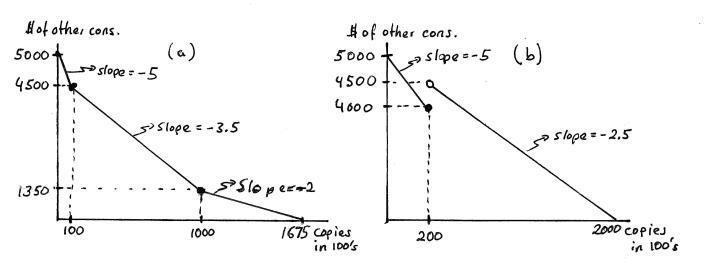
Answer: The marginal cost of the first page after 20,000 is -$499.975, and the marginal cost of the next page after that is 2.5 cents. To see the dif-ference between these, think of the marginal cost as the increase in the total photo-copy bill for each additional page When going from 20,000 to 20,001, the total bill falls by $499.975. When going from 20,001 to 20,002, the total bill rises by 2.5 cents.
B: Write down the mathematical expression for choice sets for each of the sce-narios in 2 9A(a) and 2 9A(b) (using x1 to denote “ pages copied in units of 100” and x2 to denote “dollars spent on other goods”).
Answer: The choice set in (a) is
Business Application: Supersizing: Suppose I run a fast-food restaurant and I know my customers come in on a limited budget Almost everyone that comes in for lunch buys a softdrink Now suppose it costs me virtually nothing to serve a medium versus a large soft-drink, but I do incur some extra costs when adding items (like a dessert or another side-dish) to someone’s lunch tray
A:Suppose for purposes of this exercise that cups come in all sizes, not just small, medium and large; and suppose the average customer has a lunch budget B On a graph with “ ounces of soft-drink” on the horizontal axis and “dollars spent on other lunch items” on the vertical, illustrate a customer’s budget constraint assuming I charge the same price p per ounce of soft-drink no matter how big a cup the customer gets.

Answer: Panel (a) of Exercise Graph 2 10 illustrates the original budget, with the price per ounce denoted p The horizontal intercept is the money budget B divided by the price per ounce of soft drink; the vertical intercept is just B (since the good on the vertical axis is denominated in dollars with the price of “$’s of lunch items” therefore implicitly set to 1
Exercise Graph 2 10 : (a) Original Budget; (b) The Daryls’ proposal; (c) Larry’s proposal
(a) I have three business partners: Larry, his brother Daryl and his other brother Daryl. The Daryls propose that we lower the price of the initial ounces of soft-drink that a consumer buys and then, starting at 10 ounces, we in-crease the price They have calculated that our average customer would be able to buy exactly the same number of ounces of soft-drink (if that is all he bought on his lunch budget) as under the current single price Illustrate how this will change the average customer’s budget constraint.
Answer: Panel (b) illustrates the Daryls’ proposal. The budget is initially shallower (because of the initial lower price and then becomes steeper at 10 ounces because of the new higher price.) The intercepts are un-changed because nothinghasbeen doneto allowthe average customer to buymore of non-drinkitems if that is all she buys, and because the

